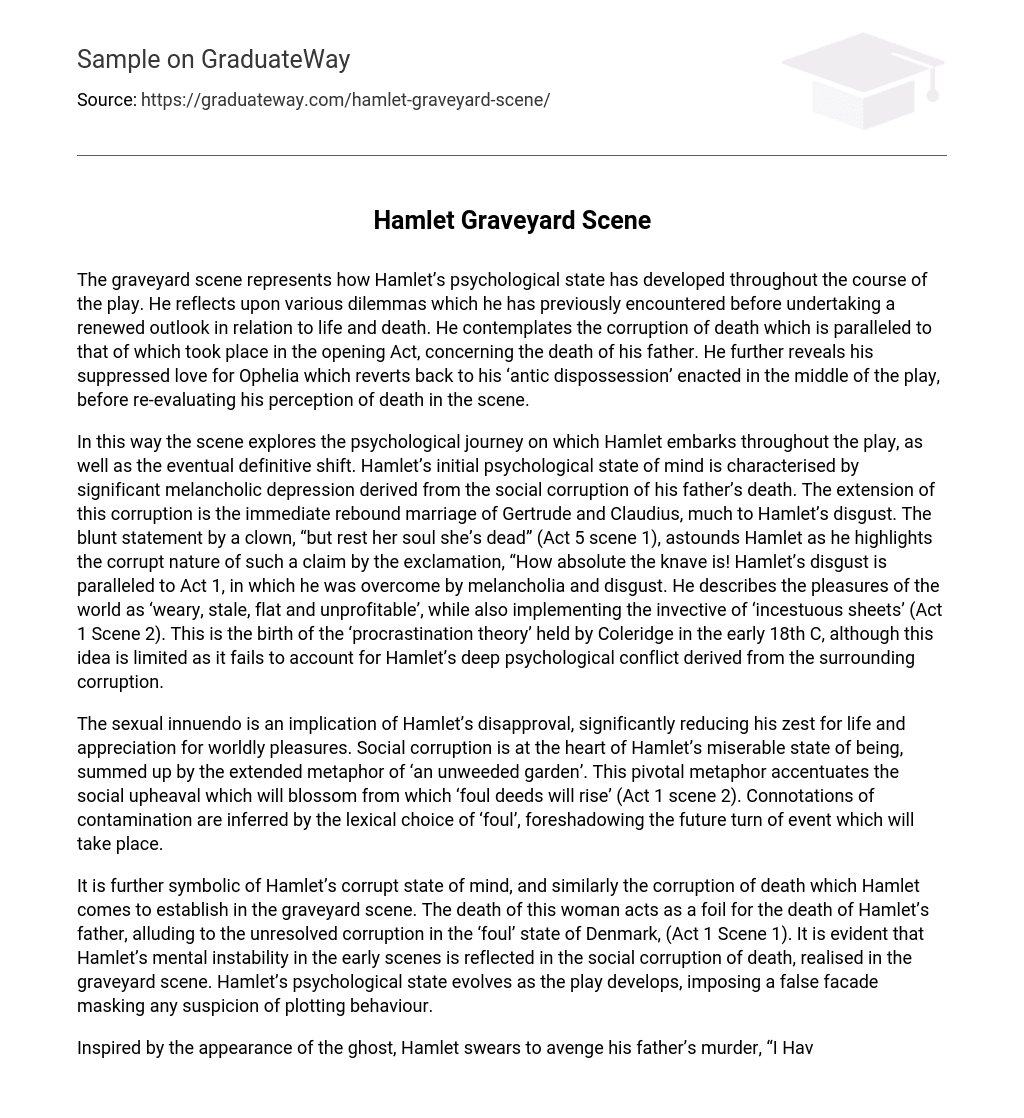The scene in the graveyard symbolizes the evolution of Hamlet’s mental state throughout the play. Here, he reflects on the various conflicts he has faced and comes to a new understanding of life and death. He compares the corruption of death to the corruption that occurred in Act 1, when his father died. He also expresses his repressed feelings for Ophelia, which he had previously acted out in a strange manner. Overall, this scene prompts Hamlet to re-evaluate his views on death.
The psychological journey that Hamlet undergoes throughout the play is explored in this scene, which also marks a definitive shift. Hamlet initially experiences significant melancholic depression caused by the social corruption surrounding his father’s death. This corruption is exemplified by Gertrude and Claudius’ immediate marriage, which disgusts Hamlet. When a clown bluntly states, “but rest her soul she’s dead” (Act 5 scene 1), Hamlet is astounded and emphasizes the corrupt nature of the claim by exclaiming, “How absolute the knave is!” This disgust mirrors his emotions in Act 1, when he was overwhelmed by melancholia and disgust. He describes the pleasures of the world as ‘weary, stale, flat and unprofitable’, and refers to the ‘incestuous sheets’ (Act 1 Scene 2). This marks the inception of Coleridge’s ‘procrastination theory’, although it is limited as it fails to account for Hamlet’s deep psychological conflict arising from the surrounding corruption.
The sexual innuendo in Hamlet’s disapproval greatly diminishes his enjoyment of life and worldly pleasures. The source of Hamlet’s misery is rooted in social corruption, as symbolized by the metaphor of ‘an unweeded garden’. This metaphor emphasizes the societal chaos that will result in the emergence of ‘foul deeds’ (Act 1 scene 2). The use of the word ‘foul’ suggests contamination, foreshadowing future events.
The text suggests that Hamlet’s corrupt state of mind, as well as the corruption of death, are symbolized by the death of a woman in the graveyard scene. This woman’s death serves as a contrast to the death of Hamlet’s father, hinting at the unresolved corruption in Denmark. It becomes clear that Hamlet’s initial mental instability is reflected in the societal corruption associated with death, which is portrayed in the graveyard scene. As the play progresses, Hamlet’s psychological state changes and he adopts a false facade to hide any signs of deceitful behavior.
The ghost’s apparition inspires Hamlet to swear vengeance for his father’s murder, as he declares, “I Have sworn’t,” in response to the ghost’s farewell, “’Adieu, adieu, remember me’ (Act 1 Scene 5). Later in the same scene, he hints at adopting a feigned madness to disguise his true intentions. This façade of madness would allow him to plot his revenge without arousing suspicion. In the graveyard scene, Hamlet confesses his love for Ophelia, stating, “I love Ophelia; forty thousand brothers/ could not with all their quantity of love make up my sum.” However, this declaration contradicts his behavior towards Ophelia in Act 3 Scene 1. He directly tells her, “I loved you not,” and hurls insults at her by suggesting she enter a nunnery. Hamlet’s deliberate deceit troubles not only Ophelia but also those who seek an explanation for his abnormal conduct. It is unclear to them that he is intentionally distancing himself from Ophelia due to his emotional instability, in a misguided effort to protect her out of love. The contemplative opening line of the scene, “to be or not to be,” alludes to the existential question of life or death.
He has not yet determined whether it is better to endure the hardships of a difficult fate or to fight against numerous difficulties. The metaphoric nature of his thoughts is important because he still cannot make a firm decision about whether he should continue seeking justice, even though he must commit regicide. This contemplation supports Helen Gardener’s theory from the 20th century that Hamlet is torn between two choices, rejecting the theory that he is simply procrastinating and ignoring his complex psychological state.
This is the central conflict Hamlet faces, one that he must keep hidden from others. The moment in the graveyard scene when he expresses his love reveals a newfound confidence and understanding that his awareness of societal corruption must be acknowledged. This declaration marks a significant turning point, as it removes his false image. During the graveyard scene, Hamlet comprehends that death is a definite and final concept. This realization dawns on him as he gazes at the skull of the court Jester.
Hamlet directly confronts the reality of death, gazing at a skull that represents death’s lifeless and unfeeling nature. He ponders the fate of everything a person has lived for, using the Jester as an example: “Where are your jokes and playful antics now? Your songs and joyous outbursts that used to fill the room with laughter?” These rhetorical questions highlight the jester’s qualities and the positive impact he had on others. As he stares at the empty skull, Hamlet recognizes that all of these things are lost when a person dies.
In his contemplation of death, Hamlet makes references to both ‘Alexander’ and ‘Imperious Caesar’, and notes that “Alexander died, Alexander was buried, Alexander returneth to dust, the dust is earth, of earth we make loam”. This listing of events following Alexander’s death emphasizes Hamlet’s belief that no matter how extraordinary a person’s life may be, they will ultimately turn to dust. This realization represents a significant change in Hamlet’s understanding of death as he discards any previous contemplation or consideration and finds solace in accepting the inevitable.
Hamlet’s ability to act without being hindered by his previous melancholic and contemplative state of mind has now been achieved. The graveyard scene reveals the evolution of Hamlet’s psyche throughout the play. His contemplation of societal corruption and ‘antic disposition’ has been eliminated, and his altered perception of death enables him to act with a clear conscience, reflecting the transformation in his psychological state.





